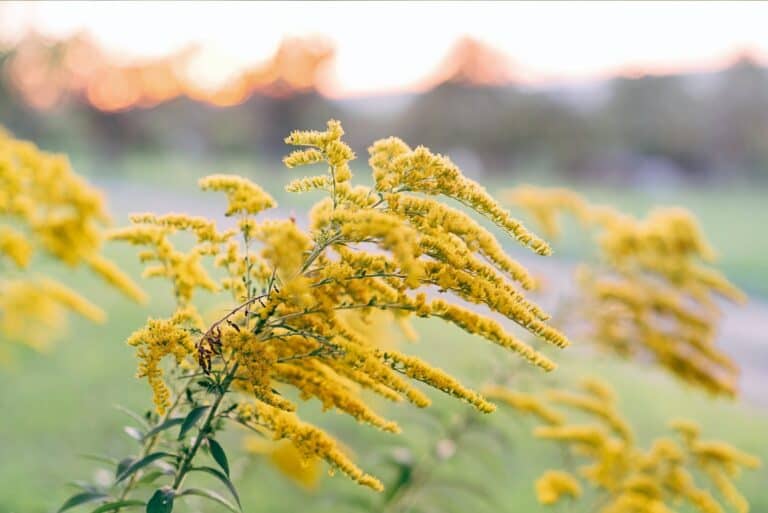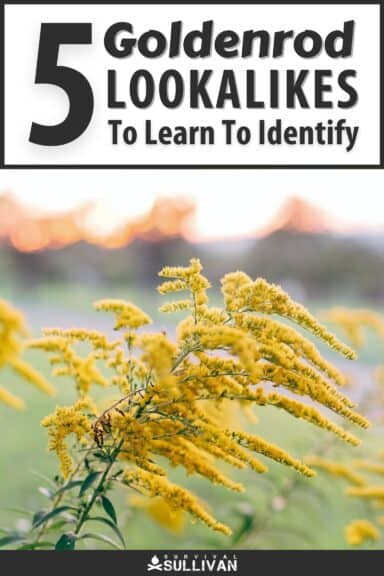Goldenrod, a proud member of the sunflower family, is one of the most iconic, beautiful and indeed useful plants found in North America. Or rather I should say, family of plants because that is what they are, with more than 130 species counted among their number with over 100 in N. America.

Goldenrod has long been used by humans, eaten and processed in various forms into food and beverages, and also dies that lend the name to everything from crayons to fountain pen ink and more.
However, foragers need to be cautious because there are quite a few Goldenrod look-alikes out there, and several of them are quite dangerous. Keep reading and I’ll tell you about five of them below…
Table of Contents
Caution: Goldenrod Species are Themselves Highly Diverse!
Before we get to the list of look-alikes, it is important to point out that there can be considerable differences in the appearance of different Goldenrod species themselves.
Some of them don’t look anything like the plants that you might be imagining, even the color of the flowers!
Each region of the United States, from the Deep South to the dusty prairies of Texas has their own species of Goldenrod, and there are over 60 species spread across the Northern part of N. America.
Accordingly, the lookalikes listed below might be more or less similar in appearance.
For this reason, it is up to you to become totally familiar with the Goldenrod species you are after, as well as its related species, and the lookalikes for both. Failing to do this could have dire consequences if you’re looking to harvest it!
1. Yellow Ironweed
- Scientific Name: Verbesina alternifolia
- Toxic?: No.
- Edible?: No.
Yellow Ironweed, also referred to as other common name of Wingstem, could be mistaken for Goldenrod at first glance if you don’t pay close attention to the flowers themselves. In any case, you might find yellow ironweed growing in some of the same places where you’d find Goldenrod, although it likes areas with significantly more moisture, and will sometimes be found immediately adjacent to ponds, creeks and streams.
Back to those flowers, look closely at them and you will see that yellow ironweed has flowers that are larger with obvious, droopy petals that look very much like miniature sunflowers.
These flowers are very different from the typically dense, clustered growth pattern of Goldenrod.
The good news is that yellow ironweed is not harmful, but neither is it helpful except as it contributes to the food cycle of various insects.
2. Rabbitbrush
- Scientific Name: Chrysothamnus nauseosus
- Toxic?: No.
- Edible?: No.
The second Goldenrod lookalike on our list gets its fanciful name from its appearance, which has a fuzzy, almost downy look similar to a rabbit’s tail. And when it grows to a modest height, it might be mistaken for a clump of Goldenrod.
However, Rabbitbrush grows much taller, up to a huge 26 feet, the top of which will be crowned with small, golden yellow flowers.
This species, unlike most species of Goldenrod, does well in sandy, dry regions. The flowers themselves also look a fair bit different upon close and expert inspection.
The flower heads are larger in size, and each head is made up of five smaller disc-shaped flowers. You can also spot it from the hairy, rubbery and gray-green stalks.
They are highly flexible, and the plant contains compounds that once led to its consideration as an option for U.S. rubber production.
3. Ragwort
- Scientific Name: Jacobaea vulgaris
- Toxic?: Yes, contains strong toxic alkaloids.
- Edible?: No.
Sometimes called Tansy Ragwort, and not to be confused with true Tansy, you might find ragwort growing anywhere that Goldenrod does, particularly in plains and pastures, along roads and animal paths, and in meadows with other sparse, shrubby vegetation.
Superficially, it looks very much like Goldenrod and that’s dangerous when you’re dealing with a plant like this.
Pay close attention and you will see that the flowers of a ragwort are not nearly as dense in growth as golden rods and the flowers themselves are also more rough-looking and less symmetrical in appearance, generally.
But don’t get them mixed up, though, because Ragwort has high concentrations of various alkaloid toxins. Significant ingestion can easily cause irreversible liver cirrhosis which will prove fatal.
4. Groundsel
- Scientific Name: Senecio vulgaris
- Toxic?: Yes, contains toxic alkaloids
- Edible?: No.
Also known as Common Groundsel or old-man-in-the-spring, this tall annual herb is commonly mistaken for Goldenrod due to its vertically oriented stems of bright, sunshine-yellow flowers.
This plant is another found all across North America and is furthermore a common invasive weed that crops up in gardens. Also like Goldenrod, it does well in disturbed ground.
You can tell the two apart, however, because Groundsel will typically bloom throughout the year and has distinctly forked, irregular leaves that look almost like arugula.
This is another common imposter and one that is unfortunately quite toxic, especially to livestock.
Although it isn’t the most toxic plant around, it’s particularly dangerous, even deadly, because the specific alkaloid toxins it contains can cause permanent and fatal damage to the liver. Don’t get taken by claims of its supposed medicinal properties!
5. Ragweed
- Scientific Name: Ambrosia artemisiifolia
- Toxic?: No, but extremely allergenic.
- Edible?: No.
The number one enemy of allergy sufferers around the continent, Ragweed is an infamous plant, although one that is not overtly dangerous.
It is, however, very easy to confuse for Goldenrod: The flowers of ragweed are a different color, usually being a pale green or sometimes a yellowish green, but they don’t take on the golden, cheery, sunny hue of true Goldenrod flowers.
However, they are very easy to mistake for one another when the blooms are young or developing.
Like Goldenrod, you’ll also find ragweed in the exact same places, much of the time even growing right next to it which will only add to the confusion!


Tom Marlowe practically grew up with a gun in his hand, and has held all kinds of jobs in the gun industry: range safety, sales, instruction and consulting, Tom has the experience to help civilian shooters figure out what will work best for them.
